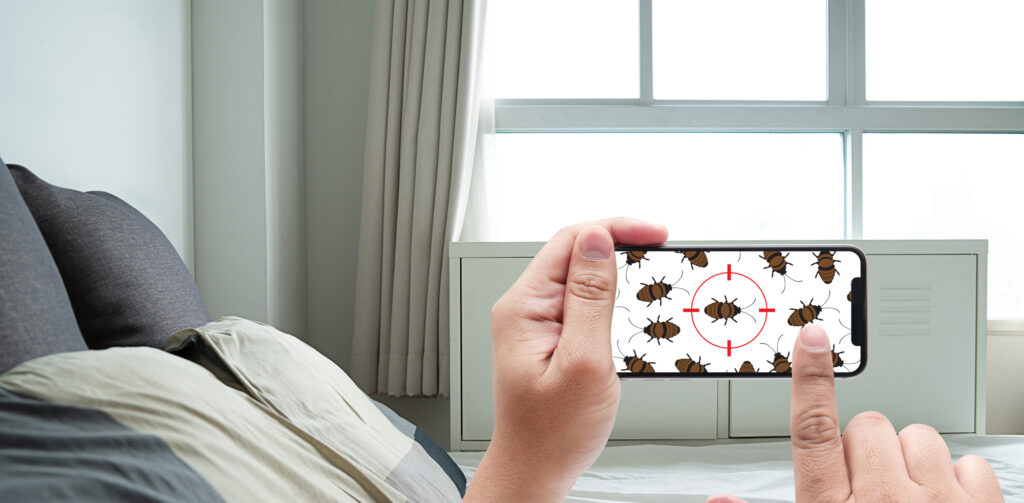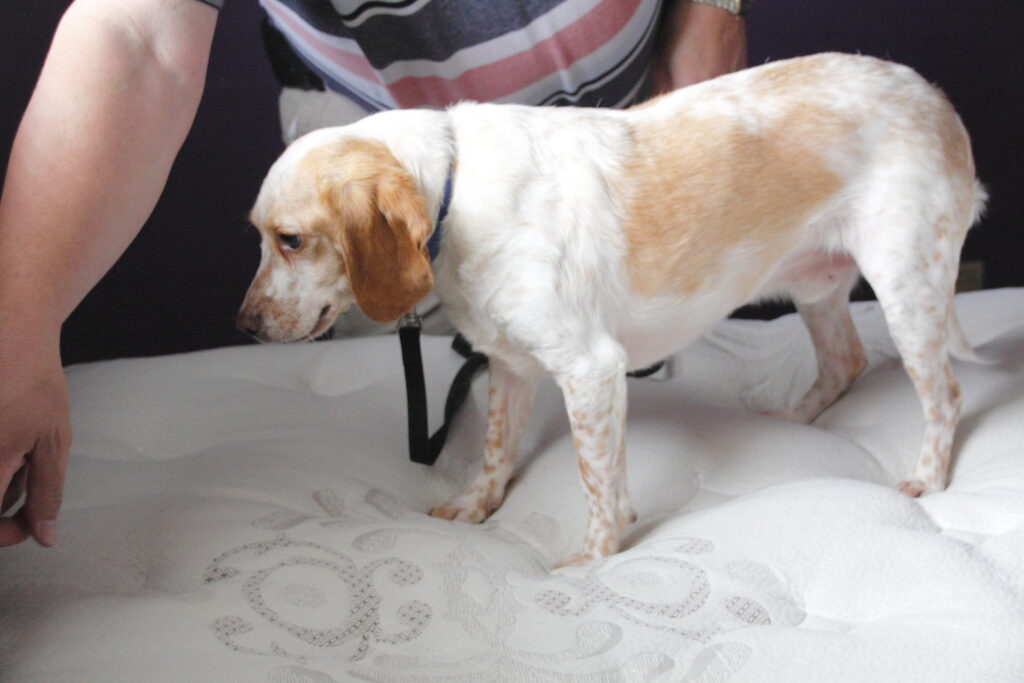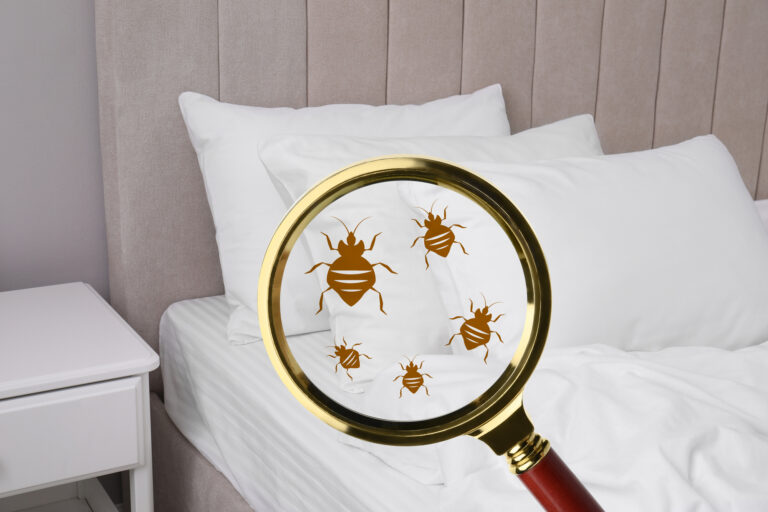Bed bugs are a massive problem for people just about everywhere, often striking without any apparent cause. In fact, one in five Americans has dealt with bed bugs (NOBBEL, Inc, 2011 NPMA “Bed Bugs in America Survey”)—something I know personally or know someone who has.
Many people associate bed bugs with rural settings, but you could be at risk in high-rise apartments. You can take action by understanding the threat and taking a few simple preventive steps.

How Common are Bed Bugs in High-Rise Apartment Complexes?
Are bed bugs a severe threat in high-rise apartments? The nature of these residences might lead to lower infestation rates. However, that’s different from what the data shows. A 2016 study published in the Journal of Medical Entomology highlights the prevalence of bed bugs in high-rise apartments, and the results may surprise you.
A thorough review of 2,372 apartments across 43 buildings in New Jersey was initiated to evaluate bed bug infestation levels. The scientists used a combination of visual inspections, professional monitoring, and resident interviews to uncover the details of infestation rates throughout these buildings.
The review found that 12.3% of individual apartments had ongoing bed bug infestations. That’s roughly 1 in 8. Even more shocking is that many infestations were unidentified before the review.
The housing authorities knew only 33% of the infestations, which means they weren’t taking effective action.
Individual residents of apartments with infestations were also often unaware of the bed bug problem. Of those who lived in infested apartments, 47% said they were already aware of bed bugs, while 49% had no idea, and 4% suspected something but weren’t sure.
The study asked people who knew about the infestations how long they had been aware of the issue. A shocking 57% said they’d had bed bugs for over six months, and 36% said more than one year.
Many had made efforts to deal with bed bugs but had yet to find success. For example, 59% of individuals with bed bugs had tried insecticides, such as foggers and sprays. Sadly, 44% said they had to discard furniture or other personal belongings.
These bed bug infestations have seriously impacted the lives of people living in these buildings. So many were unaware of the growing problem and what they could have done to stop it.

A Bed Bug Technician’s Comment for Tenants
- 12.3% of tenants had live bed bugs in their apartments, many of whom were unaware of the issue and had it for many months. How many of those tenants use the common area regularly? Be cautious. Bed bugs are hitchhikers, and common areas are easy for bed bugs to spread.
- 44% of tenants with bed bugs had previously discarded furniture and personal belongings.
a. If you decide to throw away furniture, do your neighbor a favor and make it undesirable for them to take. Write bed bugs on the furniture with a permanent marker.
b. If you see furniture on the curb, err on the safe side and assume it is better left for the trash company to pick up. It is there for a reason. - Be careful when visiting others in their high-rise apartment. Your friend may be one of the 49% of people with bed bugs but are unaware. Avoid sharing belongings and travel light. Can you leave your purse and jacket in your vehicle?
- 59% of the tenants with bed bugs had tried using insecticides. Because of insecticide overuse, many bed bugs have developed resistance! Most store-bought insecticides – Ortho Home Defense, Hot Shot, Harris, Raid, etc. – contain pyrethroids as their active ingredient.
a. Professional pest control companies use pyrethroid-resistant bed bug sprays. - Landlords were only aware of 33% of the active infestations.
a. I have noticed tenants hesitating to tell their landlords they have bed bugs. I suspect tenants either: 1). Do not want to pay for professional treatment or 2). Are worried about being evicted.
b. Landlords and Property Managers can benefit from a bed bug training program similar to the Know Bed Bugs hotel training program.

Simple and Inexpensive Wins: What Can You Do in Your High Rise?
- A well-kept and tidy home will go a long way to detecting an early infestation. Furthermore, if you need a professional bed bug treatment, cleaning your home is a part of every preparation. Bed bugs are wonderful hiders.
- Bed bug interceptors are a small investment and can detect bed bugs. If you go to amazon.com, search “bed bug interceptor” in the search bar. Here is how they work.
a. Interceptors are bowl-shaped devices placed underneath bed frame legs and couch legs.
b. Interceptors will allow bed bugs to enter the bowl, but not let them out! - Use light-colored bed sheets, bonus if white. If you have an early infestation, you may notice the signs of bed bugs before seeing them. Look for this:
a. Small red stains and smears on your bedding and pillowcases.
b. Bed bugs shed their skin as they go from an egg to an adult called molts. Look for translucent shedding.
c. Black dots can form on the corners of your mattress and box spring. - Vacuum and Steam Cleaning. Bonus if there is a handheld attachment. Many professionals vacuum and steam clean as a part of their bed bug treatment.
a. If you vacuum, make sure you empty the bag outside of the house or put it in a sealed-off trash bag.
b. Steamers will kill bed bugs on contact. You can steam your upholstery and bed frames if it is handheld. - Befriend your dryer. Running your bedding and pillowcases through the dryer will kill bed bugs.
a. If you wash your bedding first, it may not get hot enough in the dryer. We recommend either: 1). Skipping the washer, or 2). Dry the bedding twice.
b. I tell customers to run the dryer for 60-90 minutes. - If you see signs of bed bugs, tell your landlord.
a. I have found landlords are pleased their tenants are being proactive with bed bugs. They do not want them to spread to other apartments either.
b. In high-rise apartments, property managers typically have a pest control company they work with regularly and can have an inspection scheduled right away.

When It’s Time to Call the Professionals
How can you tell when it’s the right time to call the professionals? You should regularly inspect furniture and beds and watch out for signs of infestation. You may see live bed bugs, which are reddish-brown and about the size of an apple seed. You’ll likely see signs such as dark spots of waste or stains where bugs have been crushed.
Bed bug bites are often the first sign of any infestation. You may notice reddish raised bumps on your skin, often in patches. While these symptoms are not always due to bed bug bites, they’re worth looking into.
If you’ve noticed any of these signs, call a professional bed bug service company for an inspection. They implement techniques such as canine inspection to find live bed bugs and determine the extent of the infestation. From there, they can take action to resolve your bed bug problem.

How Bed Bug Treatment Works
If your inspection does show that you have bed bugs, it’s in your best interests to go with professional bed bug treatment. At-home methods using insecticides are often ineffective and can harm the health of you, your family, and your pets. You can also find yourself having to throw out more furniture and belongings.
Instead, modern bed bug solutions rely on bed bug heat treatment in Columbia, MO, St. Charles, and surrounding areas. This technique doesn’t use harmful pesticides, making it the safest and healthiest way to deal with bed bugs. Not only that, but it also delivers more reliable results than traditional methods.
Equipment is used to heat and circulate air throughout your home. This heat reaches at least 125 degrees and holds that temperature for a few hours to ensure it reaches all surfaces. The high temperature kills bed bugs at every life cycle stage, including eggs, nymphs, and adults.
There are a few steps to prepare for heat treatment, but your service provider will help. You should be prepared to remove pets, plants, certain plastics, pressurized aerosols, and other objects that the heat can damage.
Take Action on Bed Bugs Today
If you’ve noticed any signs of bed bugs in your home throughout Missouri, Arkansas, Kansas, Oklahoma, Nebraska, Iowa, or Illinois, reach out to Midwest Bed Bug Services for a rapid response. We use industry-leading heat treatment methods to deliver safe, reliable, and lasting results. Get your estimate today.
We offer bed bug treatment services in the following cities in Missouri and Illinois areas:


